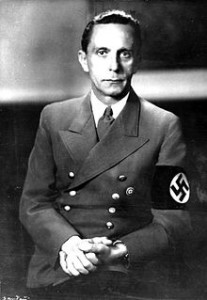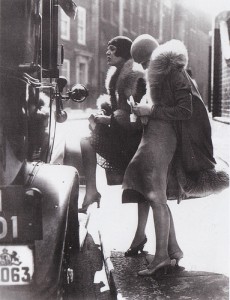
Flappers in Berlin, 1920s
Having been born in 1900, Else Neuländer-Simon’s young adulthood occurred during the Weimar Republic era of Germany. Due to the passing of Treaty of Versailles in 1919, the beginning of the 1920s was burdened with hyperinflation in Germany. Overall, the 1920s was a time of growth for Berlin and especially for women. The right to vote was granted to women in 1919 and more women in metropolitan areas such as Berlin were beginning to embrace a certain degree of independence. Young women began looking less like the feminine ideals of the 19th century. The Modern Girl had short hair cut into a bob and a short dress to match. Daily life activities also changed for women during this time. Young women were seen playing sports, smoking cigarettes, driving cars, attending dance halls, and no longer needing males to escort them places. Along with the liberating air surrounding women, innovation was also prevalent in society. Intellectuals, artists, and scholars in many fields marked Weimar Culture. Nine German citizens were awarded Nobel Prizes during the Weimar Republic, five of whom were Jewish scientist. Such an era was ideal to cultivate Else’s interest in the arts and photography.
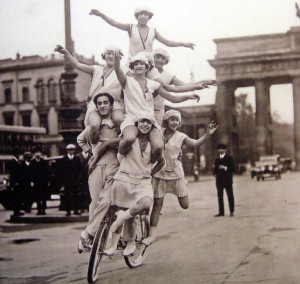
Entertainment near Brandenburg Gate, 1920s
At this time, literature and paintings were seen as having a higher rank in cultural hierarchy compared to photography and film. Both photography and film experienced enormous growth during this era. The advent of modern advertising was a powerful venue for photography, and the advertisements allowed for the mass acceptance of the art. Photography for advertisements was the main source of innovation and experimentation for this art form. Yva was able to use advertising to help her name and style of photography become well known among the fashion and female audiences. Her distinctive use of avant-garde techniques in advertisements and fashion photography became part of how audiences were able to experience modernism. Until Hitler’s rise to power in 1933 and subsequent growth of said power, Yva was able to experiment and flourish in the realm of photography without any social or political issues holding her back. Many intellectuals and artists fled Germany when Hitler ascended to power, anticipating the struggles ahead for those that stayed.
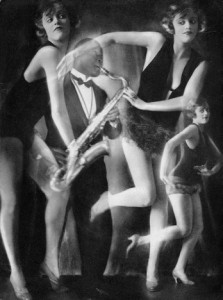
Yva: Charleston (1926-1927)
Immediately after Hitler came to power, he focused his attention on strategically and methodically removing Jews from German society. The Law for the Restoration of the Professional Civil Service was passed on April 7th, 1933. This law prevented Jews and those politically against the Nazi regime from serving as teachers, professors, judges, other government positions, lawyers, doctors, tax consultants, musicians, and notaries. Hitler also sought out to control what the German public saw in newspapers. Control of this was given to Joseph Goebbels as the head of the Ministry of Popular Enlightenment and Propaganda. In August of 1933, Else‘s artist name (Yva) was included on the blacklist of “Jewish and foreign photographers for the press” that was published in Deutsche Nachrichten. Her work remained steady though since there was little connection to her artist name of Yva and Judaism.
On October 4th, 1933, the Reich Press Law was issued. This law stated that all journalism had to be racially clean. Many Jewish and liberal editors lost their jobs soon after and those who worked for the newspapers had to take a Nazi citizenship test and prove that they were not Jewish. Jewish publishing houses, Ullstein for instance, went bankrupt and had to sell out to Eher Verlang, the Nazi publishing house in Munich. Ullstein no longer existed past 1936 and was the publisher of many of the magazines that commissioned Yva. Once the publishing house sold, all Jewish photographers names were erased from the archives, making the photos government property. Yva and other photographers could no longer collect royalties on these photos as well. By the end of 1930s, many of Else’s photo models discontinued their contacts with Studio Yva and her work became unacceptable for publication in the illustrated press. With the passing of the Nuremberg Laws in 1935, it became impossible for Else to keep her work separate from the fact that she was Jewish. Even though the studio was “aryanized” in 1936, it became difficult for Yva to continue her work due to these laws and how Jews were treated at the time. Many recognized her for her incredible work, but that was not enough to keep Studio Yva open. The last photo attributed to the studio was in August 1936 in Die Dame and the studio closed in 1938. Like many other Jews and intellectuals that remained in Berlin, Yva and her husband were sent to a concentration camp. No records remain of what happened to them.
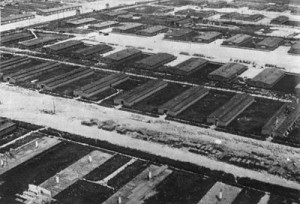
Majdanek Extermination Camp
http://www.visitberlin.de/en/feature/women-of-the-1920s
http://weimarart.blogspot.de/2010/07/yva-else-neulander-simon.html

